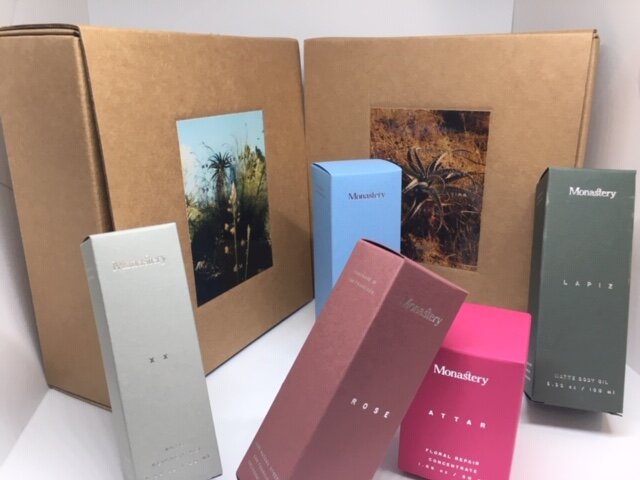Your Guide to Creating the Perfect Custom Packaging
You’ve gone the extra mile to create the perfect product that your consumer will love. Now it’s time to showcase that with unique custom packaging that accurately reflects your product and brand. There are many factors that go into creating just the right packaging, so we’ve created this guide to break it down for you; Starting with determining the key elements, to understanding the different types of packaging, designing, and beyond.
3 Important Questions to Ask Yourself
Before you can get into the fun stuff like choosing colors, fonts, and designs, it’s crucial to determine answers to some of the logistical questions. These questions will help to guide your throughout the design process for your packaging, to ensure it is not only beautiful, but functional, too.
What is the product?
The answer to this one should be simple; What is it that you’re selling? Thinking about factors such as how big it is, what materials it’s made of, how heavy it is, and if it’s fragile, will all play a role in designing your packaging. It’ll help you determine the size of the box, if it needs more secure packaging, etc.
Who’s purchasing the product?
As with any marketing initiative, understanding your target market is key when creating packaging. Determining if it is a narrow or broad audience and taking all factors into consideration will help you make your packaging appeal to the ideal consumer. You’ll want to plan for the specific demographics of your intended audience to help make your product stand out among the rest.
How is the product being sold?
Will it be sold at a convenience store? A boutique? At a farmer’s market? Online? These are important questions to consider, as something that is sold online vs. in-store will require different packaging. If it’s being shipped from an online store, it’ll need to be securely wrapped and protected in the packaging. If it’s going to be sold at a big-box store, the packaging will need to be eye-catching to stand out from the competition.
Once you’ve gone over these questions thoroughly and have clear answers to all of them, it’s time to start the design process!
Branding Information & Content to Collect
Your packaging should be reflective of your branding efforts and act as a marketing material. In order to ensure that it matches your brand aesthetic, you’ll want to gather some key elements:
Colors
Fonts
Logos
Slogans
Graphics & imagery
Written copy (name of your product, descriptions, testimonials, etc.)
Required marks (barcode, nutrition information, expiration dates, etc.)
The Packaging Design Process
Now that all the key elements and content is ready to go, it’s time to dive into the design process! This is when you’ll start to put everything together to create something incredibly unique to showcase your products.
Packaging Layers
First, you’ll want to understand the three layers of product packaging: Outer packaging, inner packaging, and inner packaging. Depending on the product, you may need one or all three of these layers. The outer packaging is the first thing that a customer sees. Whether they’re surfing the web or browsing the aisles at a store, the outer packaging is what has the opportunity to catch their eye. Next, the inner packaging is what keeps the product secured in the outer packaging. This could be bubble wrap, tissue paper, or a sealed bag. Lastly, the product packaging is what most people consider as the “packaging.” This could be the label on a bottle, the wrapper on a granola bar, or the cup your coffee is served in. Each layer is important in creating a cohesive packaging design to tell the story of your product.
Different Types of Packaging
Sometimes it’ll be obvious whether your product belongs in a box or a bottle, but other times it won’t be, and you can get creative. Thinking “outside the box” is what will help you stand out amongst the competition. Depending on your budget, you may be able to get fancy and create different shape boxes to fit the theme of your product, or unique shaped bottles to enhance the consumer experience.
Create Information Architecture
This is the step where you’ll start to piece together the branding information you collected to create a unique package design. Creatively arrange your imagery, product name, slogan, and other elements to create packaging that accurately reflects your brand and product. Mix and match your different colors, fonts, and graphics until you find just the right combination.
Evaluate the Package Design
Once you’ve come up with some great design ideas, you’ll want to take a step back to reflect. Look at what you’ve designed, and think about if it aligns with your initial intent for the packaging. Is it an honest representation of the product? Does it accurately portray the brand? What will it look like on the shelves? Will it stand out and get noticed? These are all questions you’ll want to ask internally before finalizing the packaging design and getting feedback from others.
Gather Feedback
Lastly, once you’re fully confident in your design, you’ll want to collect feedback from stakeholders, valuable decision makers, potential customers, and even random strangers to ensure that the packaging reflects your message. When you show them the packaging, you’ll want to ask them some of the key questions we covered earlier; What is the product and what does it do? Who would buy the product? What’s the message you get when you look at the packaging? If their answers match your vision, you’ll know that you told the story of your product correctly, and your custom packaging is effective!
Work with AA Global Printing to Create Custom Packaging
We hope this guide gave you some insights into how to create just the right custom packaging for your products. From choosing the right materials, to colors, messaging and beyond, there are alot of elements that go into it. If you need assistance creating custom packaging for your product, our team of experts at AA Global Printing can help! We provide environmentally friendly printing and packaging services worldwide. Learn more about our packaging services here, and get in touch with us today to get started.

